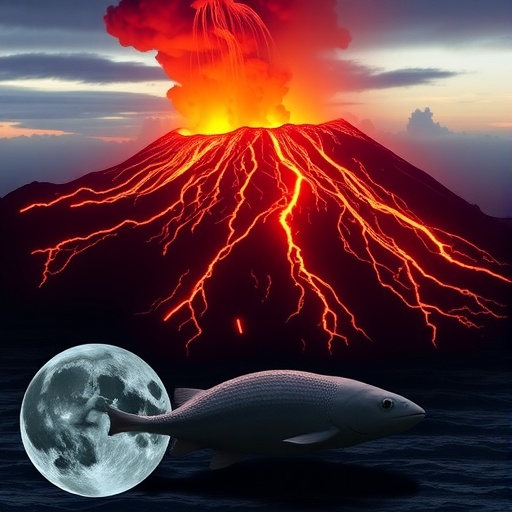A groundbreaking study conducted by an interdisciplinary team of researchers from prominent Japanese institutions has unveiled a remarkable connection between volcanic activity and marine ecosystem dynamics far beyond the eruption site. Centered on Nishinoshima Island in the Ogasawara archipelago, the research reveals how volcanic ash emitted from an extended eruption episode in 2020 catalyzed a significant surge of phytoplankton hundreds of kilometers away, challenging prior assumptions regarding the spatial influence of such geologic phenomena on ocean productivity.
Nishinoshima Island, a relatively small volcanic landmass located in the remote Ogasawara Islands southeast of mainland Japan, underwent a major eruptive phase lasting from December 2019 through July 2020. This prolonged activity released substantial amounts of volcanic ash both into the atmosphere and the surrounding ocean. The region around Nishinoshima is notable for its unique oceanographic conditions, lying adjacent to subtropical gyres known for their oligotrophic (nutrient-poor) marine waters, characterized by very low baseline chlorophyll concentrations and limited biological productivity.
The investigative team, comprising researchers from Nagoya University, Tohoku University, Meiji University, and Waseda University, utilized satellite remote sensing technologies to quantify changes in surface phytoplankton biomass induced by the volcanic ash dispersal. Their focus extended beyond the immediate vicinity of Nishinoshima to include Mukojima Island, situated approximately 130 kilometers northeast, within similarly nutrient-deficient subtropical waters. By analyzing high-resolution satellite data, they detected a conspicuous increase in chlorophyll-a concentrations around Mukojima coinciding with the ash plume transport, suggesting a previously underappreciated long-range fertilization impact.
The central methodology involved analyzing chlorophyll-a (Chl-a) data derived from two key satellite instruments. First, the Moderate Resolution Imaging Spectroradiometer (MODIS) onboard NASA’s Aqua satellite provided temporal data allowing comparison between pre-eruption, eruption, and post-eruption periods, showing an abrupt doubling of Chl-a near Mukojima during active ash fallout. Complementing this were observations from Himawari-8, a geostationary Japanese meteorological satellite delivering near-real-time measurements, which corroborated the MODIS findings by independently affirming transient algal blooms concurrent with the eruption timeframe.
To elucidate causality, the researchers integrated their observational data with numerical simulations of ocean surface currents using the Global Ocean Forecast System (GOFS) version 3.1. This enabled reconstruction of ash-laden seawater trajectories, confirming the plausibility of ash particles swept northeastward by prevailing winds and carried within ocean currents to the vicinity of Mukojima roughly six days after their initial deposition. This temporal alignment and spatial tracking strongly supports the hypothesis that nutrients derived from volcanic ash stimulated phytoplankton proliferation in an otherwise nutrient-starved environment.
Phytoplankton growth is intimately dependent on the availability of essential nutrients like iron, phosphorus, and silica, which are often limiting in subtropical gyres. Volcanic ash naturally contains such micronutrients, and its deposition into oceanic surface waters can act as a potent fertilization mechanism, briefly overturning nutrient limitations and triggering blooms. This study compellingly demonstrates that ash dispersal can have far-reaching biological implications, seeding ecosystems thousands of square kilometers away and influencing marine food webs beyond proximate volcanic consumers.
Lead investigator Professor Joji Ishizaka emphasized the importance of integrating remote sensing with numerical oceanographic modeling to capture the complexity of these processes. According to Ishizaka, “Our research took advantage of synergistic satellite data analysis and hydrodynamic simulations, allowing us to trace how volcanic ash traveled through the atmosphere and ocean and subsequently boosted primary productivity hundreds of kilometers from its source. This synergy is vital for comprehensively understanding the cascading effects of terrestrial eruptions on marine ecology.”
This finding disrupts traditional paradigms that restrict volcanic impacts predominantly to near-field zones and immediate eruption aftermaths. Instead, it introduces new perspectives on geophysical-biogeochemical linkages, highlighting how episodic terrestrial events can transiently prime nutrient cycles and biotic productivity in remote pelagic systems. Such insights have profound implications for understanding natural variability in ocean carbon cycling, climate feedback mechanisms, and resilience of marine ecosystems under changing environmental conditions.
Previously, only localized phytoplankton responses directly adjacent to volcanic islands had been documented in detail. This study innovatively expands the spatial scale of volcanic influence while quantifying temporal lag effects, bridging a crucial knowledge gap in Earth system science. The integration of multi-platform satellite sensors and ocean current models pioneers a new approach to marine hazard assessment, offering predictive capabilities for nutrient enrichment following volcanic episodes worldwide.
Fundamentally, this research underscores the dynamic interconnectedness of atmospheric, geological, and oceanic systems. Volcanic eruptions not only shape geologic and atmospheric conditions but also act as episodic “nutrient injections” into oligotrophic marine zones, transiently enhancing photosynthetic biomass and potentially supporting higher trophic levels. These interactions complicate simplistic models of ocean productivity and demand consideration in global biogeochemical and climate assessments.
As the team moves forward, there remains considerable scope to explore how these phytoplankton blooms influence local fisheries, carbon sequestration via biological pumps, and long-term ecosystem structure. Further investigations combining in-situ measurements, chemical analyses of ash content, and refined satellite monitoring could reveal differential impacts among various volcanic eruptions and global regions, advancing predictive ecological modeling.
In conclusion, the research on Nishinoshima’s 2020 eruption marks a significant milestone in understanding the far-reaching ecological consequences of volcanic ash dispersal. This pioneering work establishes that volcanic ash can act as a marine nutrient vector at mesoscale distances, intensifying phytoplankton productivity in nutrient-poor subtropical waters and reshaping ocean ecosystem dynamics. Such insights deepen our appreciation of Earth’s complex environmental systems, illuminating novel pathways through which terrestrial geophysical events influence global marine life and biogeochemical cycles.
Subject of Research: Impact of volcanic eruptions on oceanic phytoplankton productivity and biogeochemical cycles
Article Title: Relation Between Eruption at Nishinoshima and Chlorophyll-a Concentration at Ogasawara Islands in 2020
News Publication Date: 30-Sep-2025
Web References: DOI link
Image Credits: Ogasawara Village Tourism Bureau
Keywords: Earth sciences, Aquatic ecosystems, Marine ecology, Ecological dynamics, Ecosystems, Coastal ecosystems




